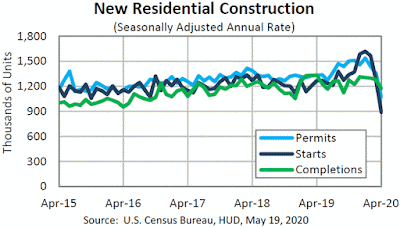Consumer Sentiment: Final Result for May 2020
Predicted: 70.0
Actual: 72.3
- Change from Previous Month: +0.696% (+0.5 point)
- Change from 12 Months Previous: -27.7% (-27.7 points)
=========
- Final ICS Reading for April 2020: 71.8
- Final ICS Reading for May 2019: 100.0
=========
From today's report:
"...Consumer sentiment has remained largely unchanged during the past two months, with the final May estimate just a half index point above the April reading. The CARES relief checks and higher unemployment payments have helped to stem economic hardship, but those programs have not acted to stimulate discretionary spending due to uncertainty about the future course of the pandemic. It should not be surprising that a growing number of consumers expected the economy to improve from its recent standstill, or that the majority still thought conditions in the economy would remain unfavorable in the year ahead. This has been a common occurrence in past cycles (see the chart).
Expectations for economic growth have always dominated at the ends of recessions, and favorable assessments about the current state of the economy are more frequent near the ends of expansions.
The gap between economic growth and the current performance of the economy is likely to grow significantly when the disastrous 2nd quarter GDP is announced. More widespread price discounting as well as low interest rates have helped to improve buying plans, but those plans still remain well below the levels recorded three months ago.
Adding to consumers' concerns about a significant expected drop in income growth, year-ahead inflation expectations rose sharply, putting extra pressure on consumers' abilities to maintain their living standards..."
=========
The ICS is derived from the following five survey questions:
- "We are interested in how people are getting along financially these days. Would you say that you (and your family living there) are better off or worse off financially than you were a year ago?"
- "Now looking ahead, do you think that a year from now you (and your family living there) will be better off financially, or worse off, or just about the same as now?"
- "Now turning to business conditions in the country as a whole, do you think that during the next twelve months we'll have good times financially, or bad times, or what?"
- "Looking ahead, which would you say is more likely: that in the country as a whole we'll have continuous good times during the next five years or so, or that we will have periods of widespread unemployment or depression, or what?"
- "About the big things people buy for their homes, such as furniture, a refrigerator, stove, television, and things like that. Generally speaking, do you think now is a good or bad time for people to buy major household items?"
- Click here for more on how the ICS is calculated.
=========
The ICS uses a 1966 baseline, i.e. for 1966, the ICS = 100. So any number that is below the 1966 baseline of 100 means that the folks who were polled recently aren't as optimistic about the U.S. economy as those polled back in 1966.
The ICS is similar to the Consumer Confidence Index in that they both measure consumer attitudes and offer valuable insight into consumer spending.
=========
The "predicted" figure is what economists were expecting, while the "actual" is the true or real figure.
=========
=========
Labels: consumer_sentiment, consumers, Coronavirus, COVID-19, COVID19, soft_data
|
--> www.FedPrimeRate.com Privacy Policy <--
CLICK HERE to JUMP to the TOP of THIS PAGE > SITEMAP < |

















